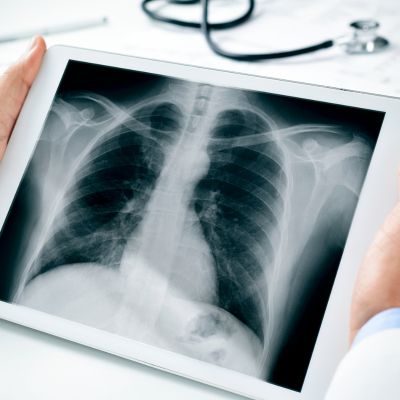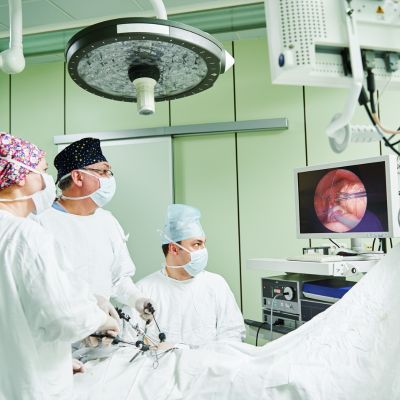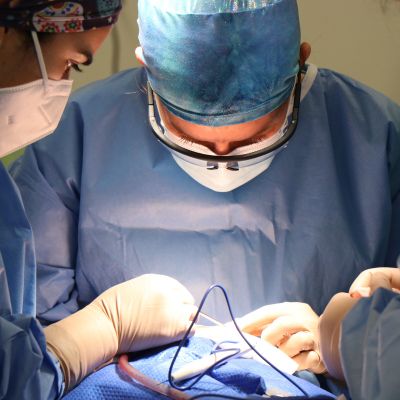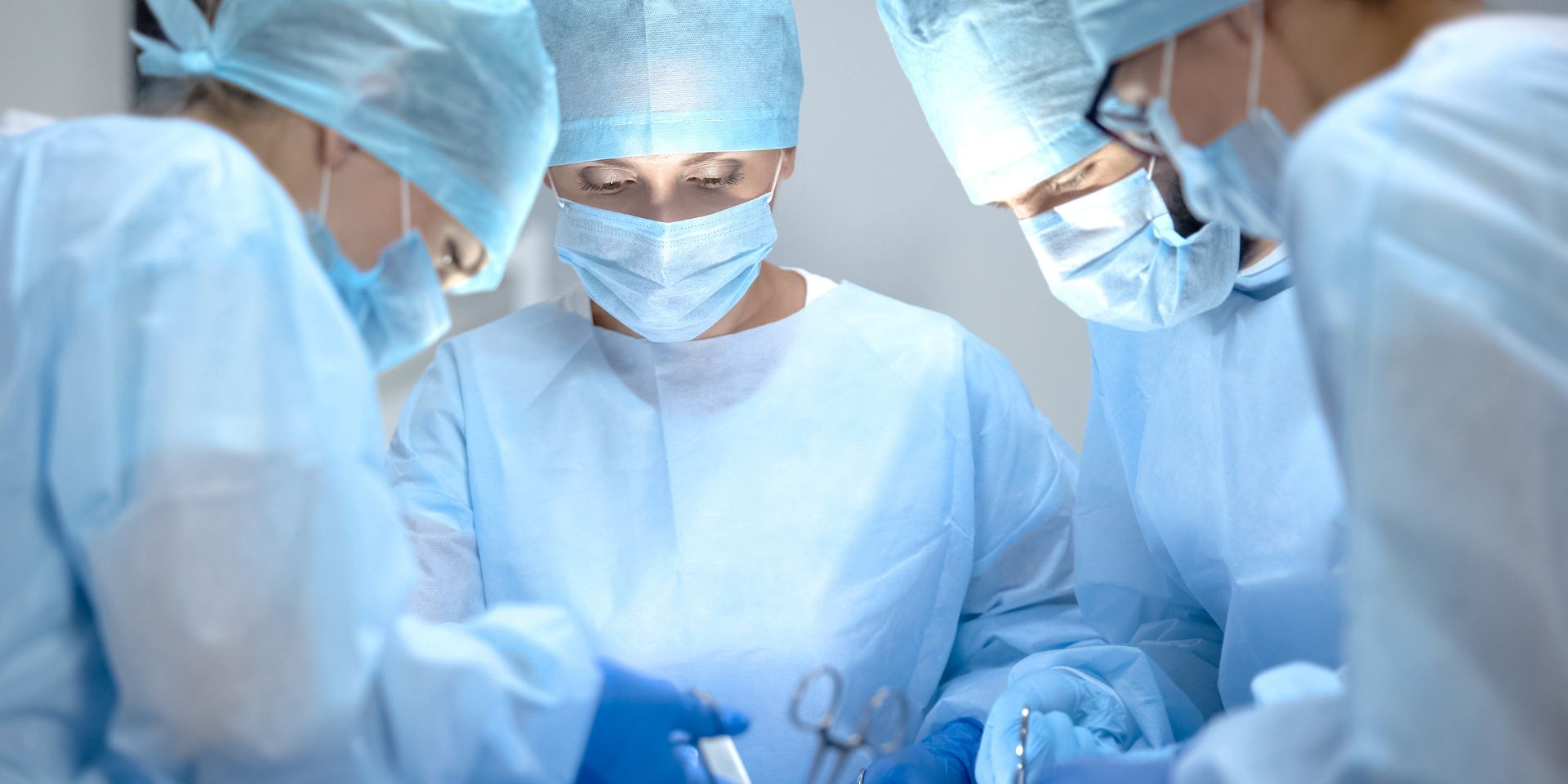Thoracic Surgery
Thoracic surgery is a specialized branch of surgical medicine focused on treating conditions affecting organs within the chest cavity (thorax). Also known as cardiothoracic surgery and chest surgery, it includes procedures related to structures in the chest such as the:
- Lungs
- Heart
- Esophagus
At Evansville Surgical Associates, our surgeons are trained to perform a variety of thoracic operations from minimally invasive procedures to complex open surgeries.
Cardiothoracic surgery is often the primary treatment option for life-threatening conditions such as:
- Lung cancer
- Heart disease
- Thoracic trauma
Many chest surgeries are serious procedures, and it’s natural to have some concerns or questions before the operation. Thanks to advancements in thoracic surgical techniques, modern chest surgeries can address some of the most challenging and impactful health issues with lasting positive outcomes for patients
Thoracic Surgery in Evansville, Indiana
Evansville Surgical Associates is your premier choice for thoracic surgery. With a team of highly skilled and experienced thoracic surgeons, you can trust in our expertise and dedication to delivering top-notch care. We emphasize a comprehensive preoperative evaluation process to ensure that you receive treatment tailored to your specific needs and circumstances.
Our surgeons stay at the forefront of minimally invasive surgical techniques, offering you faster recovery times and reduced risks. We follow a collaborative approach, working closely with multidisciplinary teams that include oncologists, pulmonologists, and other specialists as needed. Together, we work to ensure your comprehensive and optimal care.
Understanding Cardiothoracic Surgery
Thoracic surgery is concerned with diagnosing, treating, and managing conditions affecting organs within the thoracic cavity (chest area). It encompasses a diverse range of diseases and disorders involving the lungs, esophagus, mediastinum, heart, and surrounding structures.
From congenital defects to acquired ailments, the surgeons at Evansville Surgical Associates use chest surgery to address a wide array of conditions. Early procedures were often invasive and risky, but advancements have been revolutionizing the field since the late 1800s, including:
- Anesthesia
- Aseptic practices
- Medical imaging
Open thoracic surgery, characterized by large chest incisions, was once the primary approach before the 1980s. It provides direct visibility and access to organs for surgical intervention. While effective, it may result in longer recovery times and increased postoperative discomfort.
Cardiothoracic surgery has evolved over time to include minimally invasive techniques. These methods include video-assisted thoracic surgery (VATS) and robotic-assisted procedures, transforming the landscape of chest surgery.
Minimally invasive techniques utilize small incisions and specialized instruments. This reduces trauma to surrounding tissues and offers benefits such as:
- Shorter hospital stays
- Reduced recovery times
- Less postoperative pain
- Improved outcomes for patients
Early diagnosis and intervention are paramount in chest surgery to optimize patient outcomes. This is because timely detection and treatment can prevent disease progression and improve prognosis.
Chest Surgery for Descending Thoracic Aneurysms
At Evansville Surgical Associates, we primarily use thoracic surgery to treat descending thoracic aneurysms (DTAA). This condition causes localized dilations in the descending part of the aorta, which is the main artery that carries oxygen-rich blood from the heart to the rest of the body.
These aneurysms can have no symptoms or appear with symptoms such as:
- Chest or back pain,
- Shortness of breath,
- Coughing,
- Hoarseness,
- Difficulty swallowing,
Severe cases can result in aortic dissection or rupture, which can be life-threatening.
 Causes of DTAA primarily include:
Causes of DTAA primarily include:
- The buildup of substances such as fat and cholesterol in and on the artery walls
- Hypertension
- Genetic factors
- Connective tissue disorders like Marfan syndrome
- Trauma
- Infections such as syphilis
Chronic stress on the arterial walls also weakens them, leading to ballooning or bulging.
Treatment for DTAA depends on the size, location, and rate of growth of the aneurysm. Small aneurysms may be monitored regularly with imaging tests while larger or rapidly growing ones may require surgical intervention to prevent rupture.
Surgical options include open surgical repair or endovascular repair using stent grafts inserted through blood vessels. The latter can reinforce the weakened aortic wall and redirect blood flow away from the aneurysm.
Management also involves addressing underlying risk factors such as controlling blood pressure and cholesterol levels to reduce the risk of further complications. Regular follow-up is essential to monitor the aneurysm’s progression and adjust treatment plans accordingly.
Other conditions that may require thoracic surgery include:
- Lung cancer
- Esophageal cancer
- Gastroesophageal Reflux Disease (GERD)
- Hiatal hernias
- Esophageal diverticula
- Mediastinoscopy
- Sympathectomy
- Rib plating
Preparing for Cardiothoracic Surgery
Preparing for thoracic surgery is a multi-step process at Evansville Surgical Associates. It involves a comprehensive approach encompassing patient evaluation, preoperative preparation, and psychological support.
Evaluation
Cardiothoracic surgery begins with a thorough:
- Medical history review
- Physical examination
- Round of diagnostic tests such as imaging studies (CT scans, MRI)
These requirements help to accurately diagnose your condition and determine if you need surgery. Pulmonary function tests assess lung function, while cardiac evaluations determine cardiovascular health and surgical risk.
Preoperative Preparation
This step involves optimizing your health status to enhance surgical outcomes. It may include:
- Medication adjustments
- Smoking cessation
- Management of diabetes or hypertension
Blood tests assess clotting function, and chest physiotherapy may be recommended to improve respiratory function.
Psychological preparation
Psychological preparation and support are crucial for easing any anxiety you may have and promoting healthy coping mechanisms. Your fears can be alleviated by being educated about the:
- Surgical procedure
- Potential risks
- Expected outcomes
Talk to your doctor about counseling and support resources that may be available in your area. Surgery typically includes a preoperative anesthesia consultation. Most patients find this helpful to remove their concerns regarding anesthesia administration.
Recovery and Postoperative Care for Cardiothoracic Surgery
Immediate postoperative care is crucial after your thoracic surgery. Our team will closely monitor you to:
- Manage pain
- Support breathing
- Monitor vital signs
You may receive oxygen therapy, pain medication, and assistance with coughing and deep breathing exercises. This helps to prevent complications like pneumonia.
Rehabilitation and recovery typically begin shortly after surgery, starting with gentle exercises and gradually progressing to more strenuous activities. The timeline varies depending on the type of surgery and individual factors. In most cases, you can expect to return to normal activities within a few weeks to months.
Although rare, complications are possible. Potential complications include:
- Infection
- Bleeding
- Respiratory issues
These are managed through antibiotics, blood transfusions, and respiratory support as needed.
Physiotherapy plays a crucial role in preventing and managing complications. It helps you regain strength and mobility while reducing the risk of complications like blood clots. Close follow-up with healthcare providers ensures prompt identification and management of any issues that may arise.
Ready to take the next step?
Request an appointment!
Related Articles

5 of the Most Common Types of Minimally Invasive Surgery
Minimally invasive surgery is a relatively new technique that allows surgeons to perform procedures more quickly and provides patients with a faster recovery timeline after surgery. This is thanks to a special tool called a

